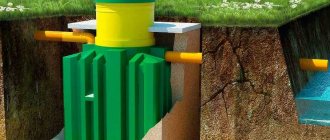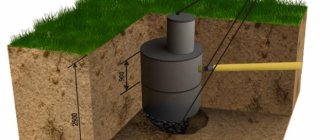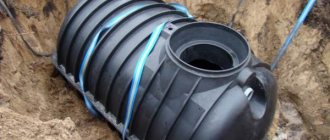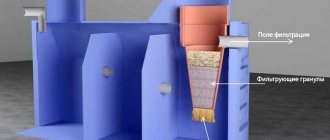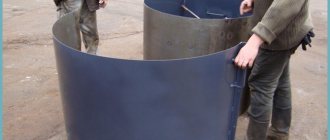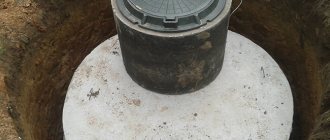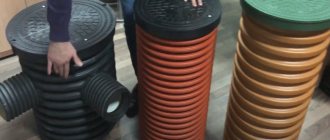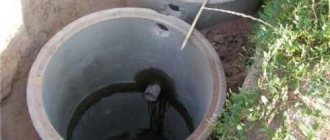The article is posted in the category|subcategory
- Septic tanks
Author
Vladimir Ermolov
—
Jul 30, 2015 Updated: March 7, 2019
- 1 Design and features of Eurocubes
- 2 Operating principle of the treatment plant
- 3 Preparation for installation
- 4 Installation work
- 5 Operating rules
- 6 Septic tank from Eurocubes video
One of the ways to ensure high-quality wastewater treatment in a private home or country house without extra expenses is to make a septic tank from Eurocubes with your own hands.
Design and features of Eurocubes
Eurocubes are convenient containers for storing and transporting various liquids, the shape of which is fully determined by the name. The material for the manufacture of Eurocubes is durable, non-toxic and chemical-resistant plastic. The thickness of the walls allows them to withstand quite large loads - depending on the model, Eurocubes have a capacity of 800 to 1000 liters. The outer frame made of thick steel wire gives the products additional strength. Outwardly, it looks like a plastic container is enclosed in a tight cage. To drain the liquid, there is a hole with a short neck, closed with a screw cap.
As a material for self-manufacturing treatment facilities, the Eurocube for a septic tank in a country house or private home has certain advantages :
- complete impermeability to water, which avoids the entry of dirty wastewater from the septic tank into the ground,
- light weight, making it possible for one person to complete all the work on installing a septic tank without the use of special equipment,
- ease of making holes and installing pipes (inlet, outlet and connecting),
- high speed of construction of a treatment plant,
- ease of maintenance of the septic tank,
- fairly high efficiency of the septic tank, subject to proper installation.
Drawing of a septic tank from two interconnected Eurocubes.
the disadvantages of septic tanks from Eurocubes are:
- low strength of plastic, increasing the risk of destruction in the cold season,
- the need to secure containers, which, due to their low weight when unfilled, can “float” during a flood.
It should be taken into account that the disadvantages of Eurocubes as septic tanks are relative, that is, they can be largely eliminated in the process of preparation for construction and during installation work.
Construction of formwork
The type of formwork (removable or permanent) should be determined taking into account the possibility of insulating the base. It is advisable to install thermal insulation in regions with frosty winters. Lumber is selected based on the characteristics of the soil. On loams, formwork is made from alder or pine; in sandstones, oak can be used. The wooden frame for the sewerage is formed in a certain sequence:
- The outer ring is made of wooden boards, knocked down into two circles. The diameter of the product is identical to the parameters of the external part of the reinforced concrete element. To make the circle stable, it is secured with wooden rivets.
- The inner ring is made without formwork, the rivets are simply knocked down into an element that is 5 mm smaller than the previous one.
- The external formwork is installed into the external one. The surface adjacent to the concrete base is coated with liquid roofing felt.
The formwork frame must be removed after 24-72 hours. If you leave the products for longer, there is a risk of damage to the outer part of the rings.
Operating principle of the treatment plant
If a septic tank is installed from Eurocubes, the scheme most often involves the presence of two series-connected containers. In order to fully utilize the volume of the second tank, it is usually placed slightly lower than the first. Slowly flowing from one Eurocube to another, the wastewater gets rid of large fractions that settle to the bottom.
The photo shows a diagram of how to make a septic tank from Eurocubes from two containers
Designing a septic tank from a Eurocube implies that treatment facilities of this type are energy-independent. They do not require air flow, which means there is no need to install a compressor. Septic tanks do not require operating costs. Settled sludge and difficult-to-decompose impurities are broken down by anaerobic (not requiring air) microorganisms. At the initial stage of operation, it is necessary to add bioactivators to homemade septic tanks made from Eurocubes without pumping to speed up the cleaning processes.
In this case, pumping out septic tank wastewater is not required: the clarified wastewater enters the filtration field, where it undergoes additional purification, and the accumulated sludge can be removed without the use of special equipment, for which it is recommended to provide a special closing hole. The frequency of removing sludge from the septic tank is approximately once every one to two years, in the autumn.
If, having made a septic tank for your dacha from Eurocubes with your own hands, you don’t want to do the pumping yourself, you always have the opportunity to call specialists with equipment for this.
The required volume of a septic tank is determined as follows: 200 liters of water per person per day are multiplied by the number of family members, and all this is also multiplied by 3. For example, for three people a septic tank with a volume of 1800 liters will be enough, that is, 1.8 cubic meter
Scheme without pumping
The exit from the second tank is located another 30 cm below the entrance, counting along the lower boundaries of the holes. From this drain, the liquid enters the aeration field.
Construction of a septic tank filtration field
The aeration field is represented by an extensive network of drainage pipes, laid as far as possible below the freezing level and above groundwater. The throughput of the field should exceed the daily norm by at least 20%, which depends on the type of soil and the thickness of the drainage layer. The entire structure is located below the level of the drain from the second chamber of the septic tank. Drainage pipes are laid with a constant slope, starting from the septic tank to the farthest point.
Preparation for installation
Having figured out how to make a septic tank from Eurocubes and acquired the materials necessary for construction, you can begin preparatory work.
When choosing a place where you plan to install a septic tank from Eurocubes without pumping it yourself, you need to take into account that it should be located no closer than 5 m to the house and 30-50 m to the well/well.
Location of the septic tank on the site
The pit for installing the septic tank is dug with a reserve. The size of the gap between the walls of the tank and the walls of the pit depends on the features of the chosen design.
- To protect the septic tank from freezing, polystyrene foam or other moisture-resistant heat insulator is often installed.
- To increase strength, they practice filling the gap with concrete or installing a “box” of boards.
In a dug pit, a concrete foundation about 20 cm thick is poured. At the hardening stage, metal hooks or rings are installed in the foundation to “anchor” plastic containers, which will prevent them from floating.
The formwork for the foundation of the septic tank is made in steps, taking into account the fact that the second cube should be installed lower in level than the first.
At the same time a filtration trench is dug , in which a perforated pipe will then be laid to drain clarified wastewater from the septic tank.
Eurocubes also need preparation for installation . The existing drain hole is sealed. It has too small a diameter and is located low, so it cannot be used for connecting pipes.
Other holes are made:
- In the first cube - for the entrance of the sewer pipe and for the flow of liquid into the second tank.
- In the second cube there is an entrance from the first tank and an exit to the filtration field.
- On the upper surfaces of each cube there is a hole for the ventilation pipe.
To supply pipelines, all holes are equipped with tees, and the joints are carefully sealed. For this purpose, you can also use plumbing cuffs of the required diameter.
Installation and sealing of pipelines
How to choose a place for sewerage from Eurocubes?
There are several rules to follow when choosing the ideal location for a septic tank.
- The laying of sewer pipes should follow the shortest path, it should be straight.
- If you need to install a septic tank further than 15 meters, you need to build an inspection well; it will be needed if blockages form.
- If it is necessary to lay pipes with bends, rotary wells are installed there at the bends.
- Unobstructed access to the septic tank must be guaranteed for vacuum cleaner equipment.
Installation work
A do-it-yourself septic tank from cubical containers is installed only after all preparatory work has been completed. The foundation concrete should have gained strength by this point. In some cases, it is practiced to partially fill the containers with water so that the lightweight reservoirs do not move with each contact.
- Having lowered the tanks into the pit, they are fixed to the foundation, connecting the metal sheathing with metal cables, clamps or other devices to the rings or hooks located in the foundation. Septic tank containers can be connected to each other by welding fittings to their iron frame.
- After this, a pipe is connected for flow between the tanks and an outlet into the filtration field from the second tank of the septic tank.
Installation of overflow pipe and ventilation - At the same time, you can install a section of pipe to the inlet of the septic tank. It will subsequently be connected to the sewer line. It is important that along the entire length from the house to the septic tank the slope of the pipeline is about 2 cm per meter of length.
- A heat insulator or a layer of thermal insulation and material to protect against compression (boards treated with an antiseptic, corrugated sheet, etc.) are installed in the gap between the walls of the pit and the tanks. In some cases, to increase the overall strength of the septic tank structure, these gaps are concreted. The metal lattice of Eurocubes in this case serves as reinforcement. Taking into account the not too high strength of the plastic, pouring is carried out carefully and in stages, pouring each subsequent portion of the solution into the gap only after the previous one has hardened.
- Ventilation pipes are installed in the openings of the upper surfaces of the Eurocubes above the tees, sealing the joints.
A finished septic tank from cubic containers in a pit before backfilling. After that, the entire structure of the septic tank is insulated with polystyrene foam. Sometimes this is followed by pouring concrete, however, this method does not allow, if necessary, to inspect the septic tank or the junction of tanks with pipelines. It is better to fill the upper surfaces with gravel, and then fill them with the soil removed when digging the pit. The drainage channel with a perforated pipe laid in it is also filled with gravel or expanded clay, which will not interfere with the passage of water, after which it is backfilled with soil.
Various schemes for constructing septic tanks are given in our separate article. Operating principle and features of different options.
We talked about the need for sewage ventilation in the house here. The article also contains rules for its installation.
Read about the construction of drainage from sewer pipes in this material https://okanalizacii.ru/drenazh/vodostok-iz-kanalizacionnyh-trub-svoimi-rukami.html
Septic tank maintenance
In order for the septic tank, and therefore the sewage system in the house, to work smoothly, it is important to prevent the containers from overflowing and to follow some simple rules.
- If you need to pump out the contents for preventive purposes, it is better to do it in the fall, at this time the biological activity of microorganisms is lower and the unpleasant odor is not so pungent.
- When evacuating the contents of the septic tank, part of the accumulated sludge is left at the bottom to ensure further normal filling of the chambers with active bacteria.
- The contents of the septic tank are pumped out using sewage disposal equipment, so you should take care of the entrance in advance.
- If you additionally add special mixtures of bacteria for septic tanks and cesspools, pumping will be required less frequently.
- After installing a septic tank, it is strictly not recommended to flush rags, matches, napkins, hygiene products and even toilet paper into the sewer.
Operating rules
For maximum durability of a septic tank made from Eurocubes and to ensure efficiency, it is important to follow the operating rules for treatment facilities of this type:
- periodically introduce special biological products for septic tanks,
- do not allow tanks to fill to the maximum during the cold season,
- equip the ventilation ducts with suction valves or use a common ventilation riser so that zones of rarefied air do not form in the sewer pipes, which prevent the free flow of liquid.
What will be needed to install a sewer system?
In addition to Eurocubes, to install the system you need to buy other material, as well as prepare tools.
- Plastic sewer pipes with a diameter of 100-110 mm for supplying wastewater to the septic tank and connecting the treatment stages, as well as the ventilation riser.
- Fittings for plastic pipes.
- Cement, sand, gravel for preparing concrete.
- Sand for filling the bottom of trenches
- Tools for cutting pipes.
- Sealant for processing joints.
- Insulation for wells, and, if necessary, for pipes.
- Fittings for connecting cubes.
- Waterproofing.
You will also need materials for soil treatment equipment. The set will depend on which filtration stage option you choose.

